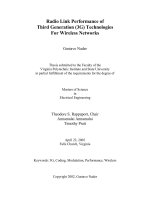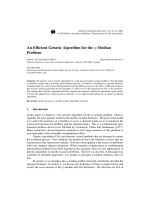SMS4 Encryption Algorithm for Wireless Networks
Bạn đang xem bản rút gọn của tài liệu. Xem và tải ngay bản đầy đủ của tài liệu tại đây (65.69 KB, 6 trang )
SMS4 Encryption Algorithm for Wireless Networks
Translated and typeset by
Whitfield Diffie of Sun Microsystems
and
George Ledin of Sonoma State University
15 May 2008
Version 1.03
SMS4 is a Chinese block cipher standard, mandated for use in protecting wireless net-
works, and issued in January 2006. The input, output, and key of SMS4 are each 128 bits.
The algorithm has 32 rounds, each of which modifies one of the four 32-bit words that make
up the block by xoring it with a keyed function of the other three words. Encryption and
decryption have the same structure except that the round key schedule for decryption is the
reverse of the round key schedule for encryption.
SMS4 Encryption Algorithm for Wireless Networks
The SMS4 algorithm is a block cipher with 128-bit key and 128-bit input block. Encryp-
tion and decryption take 32 rounds of nonlinear substitutions. Encryption and decryption
have the same structure, but the round key schedule for decryption is the reverse (goes in
the opposite order) of the round key schedule for encryption.
1. Terminology (Definitions)
1.1 Zi and ZiJie (Word and Byte)
Z
e
2
is the set of e-bit vectors. Specifically, the elements of Z
32
2
are called Zi (32-bit words),
and the elements of Z
8
2
are called ZiJie (8-bit characters, or bytes).
1.2 S box
The S (substitution) box takes in 8 bits and outputs 8 bits. It is written Sbox(.).
1.3 Fundamental Operations
The two fundamental operations used by this algorithm are:
⊕ the bitwise XOR of two 32-bit vectors,
<<< i the circular shift of a 32-bit word, with i bits shifted left.
1.4 Input and output blocks, and key
The 128-bit input block consists of four 32-bit words M K = (MK
1
, MK
2
, MK
3
, MK
4
)
or MK
i
(i = 0, 1, 2, 3).
The round key schedule, derived from the encryption key, is represented by (rk
0
, rk
1
, . . . , rk
31
),
where each rk
i
(i = 0, . . . , 31) is 32 bits long.
The 128-bit output block consists of four 32-bit words F K = (F K
0
, F K
1
, F K
2
, F K
3
).
For decryption, the round key schedule is represented by CK = (CK
0
, CK
1
, . . . , CK
31
) or
F K
i
(i = 0, . . . , 3), CK
i
(i = 0, . . . , 31).
2. The round function F
This algorithm uses a nonlinear substitution structure, encrypting 32 bits at a time. This
is called a one-round exchange. To illustrate, consider a one-round-substitution:
Let the 128-bit input block be the four 32-bit elements
(X
0
, X
1
, X
2
, X
3
) ∈ (Z
32
2
)
4
, with rk ∈ Z
32
2
, then F is given by
F (X
0
, X
1
, X
2
, X
3
, rk) = X
0
⊕ T(X
1
⊕ X
2
⊕ X
3
⊕ rk)
2
2.1 Mixer-substitution T
T is a substitution that generates 32 bits from 32 bits T : Z
32
2
→ Z
32
2
. This substitution
is a reversible process. It consists of a non-linear substitution, τ , and a linear substitution
L, i.e., T (.) = L(τ (.)).
2.1.1 Non-linear substitution τ
τ applies 4 S-boxes in parallel.
Let a 32-bit input word be A = (a
0
, a
1
, a
2
, a
3
) ∈ (Z
8
2
)
4
, where each a
i
is an 8-bit character.
Let the 32-bit output word be B = (b
0
, b
1
, b
2
, b
3
) ∈ (Z
8
2
)
4
, given by
(b
0
, b
1
, b
2
, b
3
) = τ (A) = (Sbox(a
0
), Sbox(a
1
), Sbox(a
2
), Sbox(a
3
))
2.1.2 Linear substitution L
B ∈ Z
32
2
, the 32-bit output word of the non-linear substitution τ will be the input word
of the linear substitution L. Let C ∈ Z
32
2
be the 32-bit output word generated by L. Then
C = L(B) = B ⊕ (B <<< 2) ⊕ (B <<< 10) ⊕ (B <<< 18) ⊕ (B <<< 24)
2.2 S box
All Sbox numbers are in hexadecimal notation.
0 1 2 3 4 5 6 7 8 9 a b c d e f
0 d6 90 e9 fe cc e1 3d b7 16 b6 14 c2 28 fb 2c 05
1 2b 67 9a 76 2a be 04 c3 aa 44 13 26 49 86 06 99
2 9c 42 50 f4 91 ef 98 7a 33 54 0b 43 ed cf ac 62
3 e4 b3 1c a9 c9 08 e8 95 80 df 94 fa 75 8f 3f a6
4 47 07 a7 fc f3 73 17 ba 83 59 3c 19 e6 85 4f a8
5 68 6b 81 b2 71 64 da 8b f8 eb 0f 4b 70 56 9d 35
6 1e 24 0e 5e 63 58 d1 a2 25 22 7c 3b 01 21 78 87
7 d4 00 46 57 9f d3 27 52 4c 36 02 e7 a0 c4 c8 9e
8 ea bf 8a d2 40 c7 38 b5 a3 f7 f2 ce f9 61 15 a1
9 e0 ae 5d a4 9b 34 1a 55 ad 93 32 30 f5 8c b1 e3
a 1d f6 e2 2e 82 66 ca 60 c0 29 23 ab 0d 53 4e 6f
b d5 db 37 45 de fd 8e 2f 03 ff 6a 72 6d 6c 5b 51
c 8d 1b af 92 bb dd bc 7f 11 d9 5c 41 1f 10 5a d8
d 0a c1 31 88 a5 cd 7b bd 2d 74 d0 12 b8 e5 b4 b0
e 89 69 97 4a 0c 96 77 7e 65 b9 f1 09 c5 6e c6 84
f 18 f0 7d ec 3a dc 4d 20 79 ee 5f 3e d7 cb 39 48
For example, if the input to the Sbox is ’ef’, then go to e-th row and f-th column, to find
Sbox(’ef’)=’84’.
3
3. Encryption and decryption
Let the reverse substitution R be:
R(A
0
, A
1
, A
2
, A
3
) = (A
3
, A
2
, A
1
, A
0
), A
i
∈ Z
32
2
, i = 0, 1, 2, 3.
Let the plaintext input be (X
0
, X
1
, X
2
, X
3
) ∈ (Z
32
2
)
4
, the ciphertext output be (Y
0
, Y
1
, Y
2
, Y
3
) ∈
(Z
32
2
)
4
, and the encrypting key be rk
i
∈ Z
32
2
, i = 0, 1, 2, . . . , 31. Then encryption proceeds as
follows:
X
i+4
= F (X
i
, X
i+1
, X
i+2
, X
i+3
, rk
i
) = X
i
⊕ T(X
i+1
⊕ X
i+2
⊕ X
i+3
⊕ rk
i
), i = 0, 1, . . . , 31
(Y
0
, Y
1
, Y
2
, Y
3
) = R(X
32
, X
33
, X
34
, X
35
) = (X
35
, X
34
, X
33
, X
32
).
This algorithm’s encryption and decryption methods have the same structure, except the
order in which the round keys are used is reversed.
The key order for encryption is: (rk
0
, rk
1
, . . . rk
31
). The key order for decryption is:
(rk
31
, rk
30
, . . . rk
0
).
4. Key expansion when encrypting
The rk
i
round key used for encrypting in this algorithm is derived from the encryption
key M K.
Let M K = (MK
0
, MK
1
, MK
2
, MK
3
), MK
i
∈ Z
32
2
, i = 0, 1, 2, 3; K
i
∈ Z
32
2
, i = 0, 1, . . . , 31;
rk
i
∈ Z
32
2
, i = 0, 1, . . . , 31; the derivation proceeds as follows:
First,
(K
0
, K
1
, K
2
, K
3
) = (M K
0
⊕ FK
0
, MK
1
⊕ FK
1
, MK
2
⊕ FK
2
, MK
3
⊕ FK
3
)
Then for i = 0, 1, 2, . . . , 31:
rk
i
= K
i+4
= K
i
⊕ T
(K
i+1
⊕ K
i+2
⊕ K
i+3
⊕ CK
i
)
Notes:
(1) T
substitution uses the same T as in encryption, except the linear substitution L is
changed to L
:
L
(B) = B ⊕ (B <<< 13) ⊕ (B <<< 23);
(2) The system parameter F K, given in hexadecimal notation is
F K
0
= (a3b1bac6), F K
1
= (56aa3350), F K
2
= (677d9197), F K
3
= (b27022dc).
(3) The constant parameter CK is calculated as follows:
Let ck
i,j
be the j-th byte of CK
i,j
(i = 0, 1, . . . , 31; j = 0, 1, 2, 3), i.e., CK
i
=
(ck
i,0
, ck
i,1
, ck
i,2
, ck
i,3
) ∈ (Z
8
2
)
4
, then ck
i,j
= (4i + j) × 7 (mod 256). The 32 constants
CK
i
are represented in hexadecimal as tabulated below.
00070e15, 1c232a31, 383f464d, 545b6269,
70777e85, 8c939aa1, a8afb6bd, c4cbd2d9,
e0e7eef5, fc030a11, 181f262d, 343b4249,
50575e65, 6c737a81, 888f969d, a4abb2b9,
c0c7ced5, dce3eaf1, f8ff060d, 141b2229,
30373e45, 4c535a61, 686f767d, 848b9299,
a0a7aeb5, bcc3cad1, d8dfe6ed, f4fb0209,
10171e25, 2c333a41, 484f565d, 646b7279
4
5. Encryption examples
Below are encryption examples of this algorithm’s ECB (electronic code book mode)
calculation method. We use this to verify the correctness of this algorithm’s encryption.
The numbers are represented in hexadecimal notation.
Example 1: Encrypt plaintext with key once
plaintext: 01 23 45 67 89 ab cd ef fe dc ba 98 76 54 32 10
encrypting key: 01 23 45 67 89 ab cd ef fe dc ba 98 76 54 32 10
rk and the output in each round:
rk[ 0] = f12186f9 X[ 0] = 27fad345
rk[ 1] = 41662b61 X[ 1] = a18b4cb2
rk[ 2] = 5a6ab19a X[ 2] = 11c1e22a
rk[ 3] = 7ba92077 X[ 3] = cc13e2ee
rk[ 4] = 367360f4 X[ 4] = f87c5bd5
rk[ 5] = 776a0c61 X[ 5] = 33220757
rk[ 6] = b6bb89b3 X[ 6] = 77f4c297
rk[ 7] = 24763151 X[ 7] = 7a96f2eb
rk[ 8] = a520307c X[ 8] = 27dac07f
rk[ 9] = b7584dbd X[ 9] = 42dd0f19
rk[10] = c30753ed X[10] = b8a5da02
rk[11] = 7ee55b57 X[11] = 907127fa
rk[12] = 6988608c X[12] = 8b952b83
rk[13] = 30d895b7 X[13] = d42b7c59
rk[14] = 44ba14af X[14] = 2ffc5831
rk[15] = 104495a1 X[15] = f69e6888
rk[16] = d120b428 X[16] = af2432c4
rk[17] = 73b55fa3 X[17] = ed1ec85e
rk[18] = cc874966 X[18] = 55a3ba22
rk[19] = 92244439 X[19] = 124b18aa
rk[20] = e89e641f X[20] = 6ae7725f
rk[21] = 98ca015a X[21] = f4cba1f9
rk[22] = c7159060 X[22] = 1dcdfa10
rk[23] = 99e1fd2e X[23] = 2ff60603
rk[24] = b79bd80c X[24] = eff24fdc
rk[25] = 1d2115b0 X[25] = 6fe46b75
rk[26] = 0e228aeb X[26] = 893450ad
rk[27] = f1780c81 X[27] = 7b938f4c
rk[28] = 428d3654 X[28] = 536e4246
rk[29] = 62293496 X[29] = 86b3e94f
rk[30] = 01cf72e5 X[30] = d206965e
rk[31] = 9124a012 X[31] = 681edf34
ciphertext: 68 1e df 34 d2 06 96 5e 86 b3 e9 4f 53 6e 42 46
Example 2: Use the same encryption key and encrypt the plaintext again and again 1,000,000
times.
plaintext: 01 23 45 67 89 ab cd ef fe dc ba 98 76 54 32 10
encrypting key: 01 23 45 67 89 ab cd ef fe dc ba 98 76 54 32 10
ciphertext: 59 52 98 c7 c6 fd 27 1f 04 02 f8 04 c3 3d 3f 66
5









